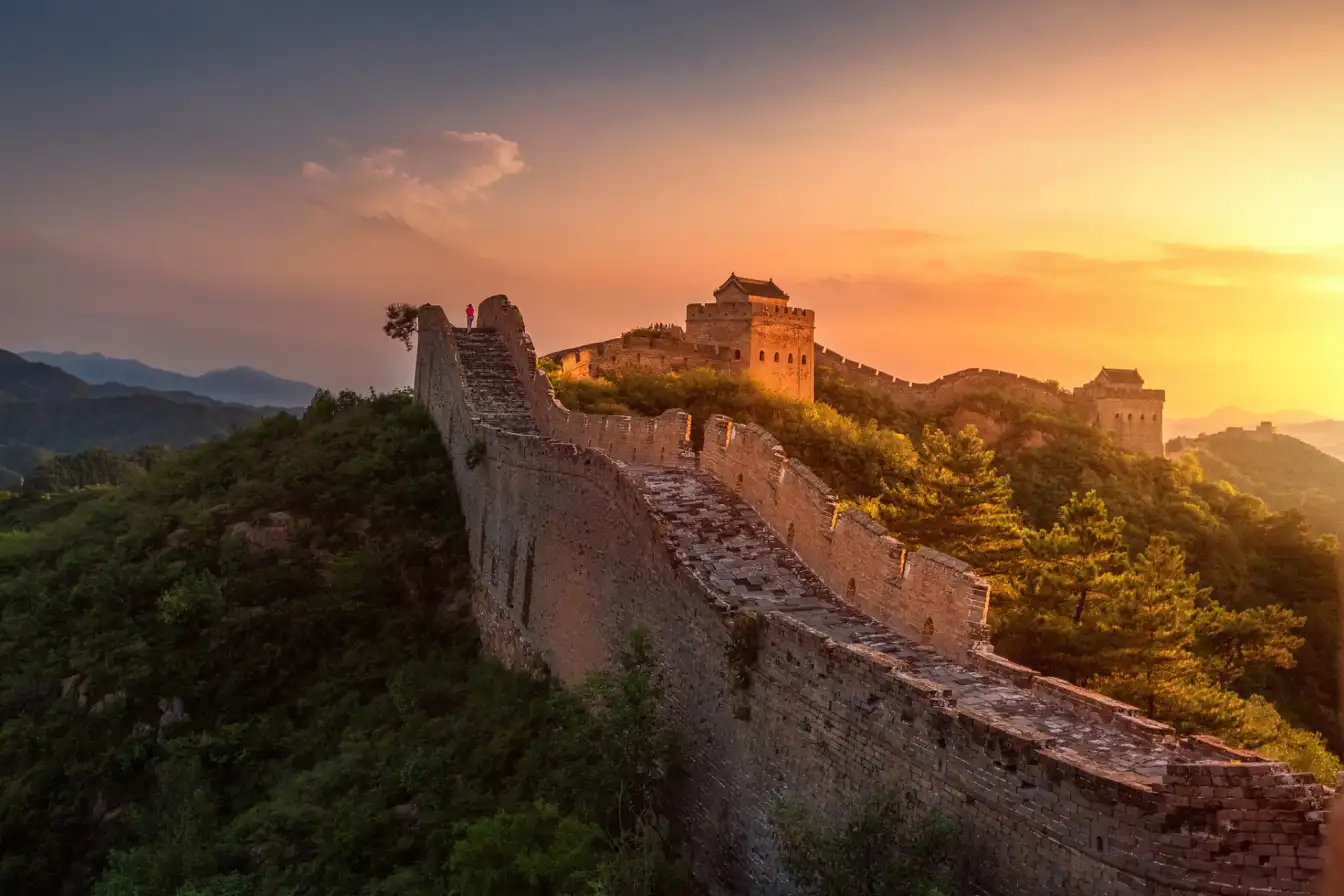
The Great Wall: Iconic Landmark of China
1. Location and Overview 🏰
Location: The Great Wall, also known as 长城 (Chángchéng) in Chinese, stretches across northern China, winding its way through rugged landscapes and majestic mountains.
Overview: The Great Wall is one of the most iconic landmarks in the world, spanning approximately 21,196 kilometers (13,170 miles) in total length. It was originally built over 2,000 years ago during the Qin Dynasty and later expanded during the Ming Dynasty. The wall served as a formidable defensive barrier, protecting China from invasions and raids. Today, it stands as a symbol of China's rich history and enduring strength.
2. Unique Features 🌟
- Engineering Marvel: The Great Wall is a testament to ancient engineering prowess, featuring massive stone and brick fortifications that traverse diverse terrain.
- Cultural Heritage: It is a UNESCO World Heritage Site, recognized for its historical significance and architectural grandeur.
- Scenic Beauty: Offering breathtaking views of rolling hills, valleys, and distant mountains, the Great Wall is a photographer's paradise.
- Symbol of Unity: The wall symbolizes the unity and determination of the Chinese people throughout history.
3. Seasonal Changes 🌷🌞🍁❄️
Spring (March to May): Mild temperatures and blooming wildflowers make spring an ideal time for hiking and sightseeing along the wall.
Summer (June to August): Warm weather allows for outdoor activities, but crowds can be heavier. Early mornings or late afternoons are best for avoiding the heat and crowds.
Autumn (September to November): Cool and crisp weather, with colorful foliage painting the surrounding landscape, providing stunning photo opportunities.
Winter (December to February): Cold temperatures and occasional snow create a serene atmosphere, but some sections of the wall may be closed due to weather conditions.
4. Best Time to Visit ⏰
The best time to visit the Great Wall is during spring (April to May) and autumn (September to October) when the weather is mild, and the scenery is breathtaking.
5. Travel Tips 🧳✈️
- Choose Less Crowded Sections: Avoid overcrowded sections like Badaling and opt for quieter areas like Mutianyu or Jinshanling for a more peaceful experience.
- Wear Comfortable Shoes: The terrain can be rugged and steep in some areas, so wear sturdy footwear for walking or hiking.
- Stay Hydrated: Bring plenty of water, especially during warmer months, as there may not be many opportunities to purchase drinks along the way.
- Bargain at Souvenir Stalls: If shopping for souvenirs, don't be afraid to bargain with vendors for better prices.
- Be Mindful of Scams: Beware of scams or aggressive sellers offering overpriced items or services.
- Respect the Heritage: Help preserve the wall by not littering, graffitiing, or removing bricks as souvenirs.
6. Cultural Significance 🎭🎶
The Great Wall embodies China's rich cultural heritage and historical legacy, symbolizing unity, perseverance, and the spirit of the Chinese people. It has inspired countless legends, poems, and artworks throughout the centuries and remains a source of national pride.
7. Tourist Attractions 🏞️📸
- Badaling Great Wall (八达岭长城): One of the most visited sections, offering panoramic views and easy accessibility.
- Mutianyu Great Wall (慕田峪长城): Renowned for its picturesque surroundings and well-preserved architecture.
- Jinshanling Great Wall (金山岭长城): A favorite among hikers and photographers, featuring rugged terrain and breathtaking vistas.
- Simatai Great Wall (司马台长城): Known for its steep gradients and stunning night views when illuminated.
- Juyongguan Pass (居庸关): A strategically important pass with impressive fortifications and historical significance.
- Huanghuacheng Great Wall (黄花城长城): Unique for its submerged sections and scenic reservoir views.
- Shanhaiguan Pass (山海关): Where the Great Wall meets the Bohai Sea, offering a symbolic starting or ending point for travelers.
- Jiankou Great Wall (箭扣长城): Renowned for its rugged beauty and unrestored condition, providing an authentic experience.
8. Nearby Attractions 🗺️
- Beijing (北京): Explore the Forbidden City, Temple of Heaven, and other historical sites in China's capital city.
- Summer Palace (颐和园): Wander through this vast imperial garden complex, renowned for its architectural splendor and scenic beauty.
- Ming Tombs (明十三陵): Discover the final resting place of Ming Dynasty emperors, surrounded by tranquil landscapes and ancient architecture.
9. How to Get There ✈️🚗
- By Air: The closest major airport is Beijing Capital International Airport (北京首都国际机场), with domestic and international flights connecting to major cities worldwide.
- By Train: High-speed trains and regular trains connect Beijing with cities near the Great Wall, such as Badaling, Mutianyu, and Jinshanling.
- By Bus: Public buses and tourist buses operate from Beijing to various sections of the Great Wall, offering affordable transportation options.
- By Car: Renting a car or hiring a private driver allows for flexibility and convenience, especially for visiting remote sections of the wall.
10. Practical Information 💼💰
- Ticket Prices: Admission fees vary depending on the section of the Great Wall visited, ranging from approximately 40 to 150 RMB ($6 to $23 USD).
- Opening Hours: Most sections are open daily from early morning (around 7:00 AM) to late afternoon (around 5:00 PM).
- Free Admission: Some sections offer free admission for children under a certain age or on specific holidays, so check in advance.
- Facilities: Visitor centers, restrooms, and food stalls are available at major tourist sections, but facilities may be limited in more remote areas.
11. Local Cuisine 🍲🥢
- Peking Duck (北京烤鸭): Enjoy this iconic dish of crispy duck skin and succulent meat, served with pancakes and hoisin sauce.
- Dumplings (饺子): Indulge in a variety of dumplings filled with meat, vegetables, or seafood, a popular Chinese comfort food.
- Hotpot (火锅): Warm up with a steaming hotpot meal, featuring a simmering broth and a selection of meats, vegetables, and noodles.
- Stir-fried Noodles (炒面): Savor wok-tossed noodles with savory sauces and fresh ingredients, a favorite street food option.
- Ma Po Tofu (麻婆豆腐): Try this spicy Sichuan dish of tofu cubes cooked in a flavorful chili sauce with minced meat and Sichuan peppercorns.
- Kung Pao Chicken (宫保鸡丁): Delight in tender chicken stir-fried with peanuts, vegetables, and chili peppers, seasoned with a tangy and slightly sweet sauce.
- Spring Rolls (春卷): Enjoy crispy spring rolls filled with vegetables, shrimp, and sometimes pork, served with a dipping sauce.
- Sichuan Hot and Sour Soup (酸辣汤): Warm your taste buds with this tangy and spicy soup featuring mushrooms, tofu, bamboo shoots, and sometimes pork.
12. Precautions to Take ⚠️🧐
- Wear Comfortable Clothing: The Great Wall involves walking and sometimes hiking, so wear comfortable clothes and appropriate footwear.
- Stay Hydrated: Bring plenty of water, especially during warmer months, to prevent dehydration.
- Beware of Crowds: Some sections of the wall can get crowded, especially during holidays and peak tourist seasons. Plan your visit accordingly to avoid large crowds.
- Be Cautious of Steep Areas: Some parts of the wall may have steep inclines or uneven steps, so proceed with caution and watch your step.
- Protect Yourself from the Sun: Apply sunscreen, wear a hat, and bring sunglasses to shield yourself from the sun's rays, as there may be limited shade along the wall.
13. Conclusion 🌟👋
The Great Wall of China is not just a historical marvel but also a testament to human ingenuity and perseverance. Visiting this iconic landmark offers a glimpse into China's rich cultural heritage and provides an unforgettable experience for travelers seeking adventure, history, and natural beauty. Whether you explore its ancient ramparts, marvel at its breathtaking vistas, or contemplate its enduring legacy, the Great Wall promises an awe-inspiring journey through time and tradition. Plan your visit today and embark on an unforgettable adventure along one of the world's most iconic wonders.





















Comments
Leave a reply